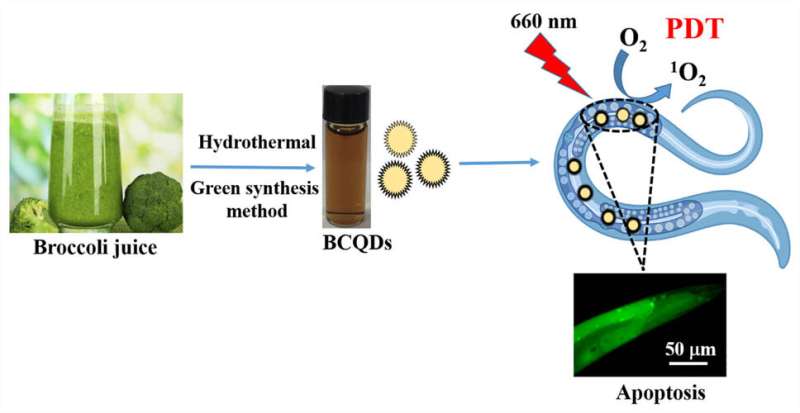Easy and high-throughput model for evaluating efficiency of photodynamic agent

Recently, researchers led by Prof. Huang Qing at the Hefei Institutes of Physical Science (HFIPS) of the Chinese Academy of Sciences (CAS) provided a new photodynamic agent and introduced Caenorhabditis elegans as an easy and high throughput model to evaluate the photodynamic agent efficiency. Results were published in Biomaterials Science.
Conventional photosensitizers have drawbacks such as low singlet oxygen (1O2) quantum yield and the problem of photobleaching, which limit the clinical application of photodynamic therapy (PDT).
In this study, carbon quantum dots (CQDs) derived from broccoli, a natural biomass carbon source, were fabricated by a simple hydrothermal method as photodynamic agents, showing excellent photodynamic ability testified in the C. elegans model. The prepared broccoli-derived CQDs (BCQDs) exhibited high photostability, excellent water solubility, and could generate (1O2) effectively under irradiated light with a wavelength 660 nm.
According to the researchers, the PDT efficiency of BCQDs by causing DNA damage in worms and ultimately inducing germline apoptosis was confirmed by measuring the fold induction of egl-1 in the loss function mutants hus-1 (op244) and cep-1 (w40).
In addition, the lack of germline apoptosis in the mutants with the loss of function of the genes for germline apoptosis due to DNA damage like hus-1(op244), cep-1(w40), and egl-1(n487) revealed that PDT efficiency of BCQDs was dependent on the induction of germline apoptosis mediated by the cep-1/p53 pathway upon DNA damage.
This work has not only provided the effective material for the potential PDT application but also introduced a rapid and high-throughput screening model for future PDT research.
More information: Shereen M. El-Sherbiny et al, Green synthesis of broccoli-derived carbon quantum dots as the effective photosensitizer for PDT effect testified in the model of mutant Caenorhabditis elegans, Biomaterials Science (2022). DOI: 10.1039/D2BM00274D
Journal information: Biomaterials Science
Provided by Chinese Academy of Sciences





















